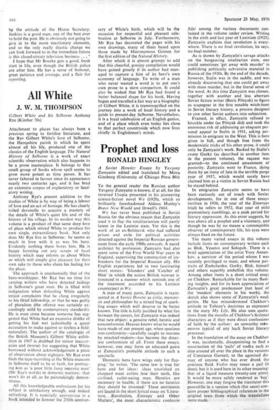All White
J. W. M. THOMPSON
Gilbert White and his Selborne Anthony Rye (Kimber 70s) Attachment to places has always been a precious spring to fertilise literature, and the Rev Gilbert White's love of Selborne, the Hampshire parish in which he spent almost all his life, produced one of the classics of the English language. The Natural History of Selborne is a work of exact scientific observation which also happens to be a prose masterpiece. It belongs to that small group of hooks whose spell seems to grow more potent as time passes. It has never faltered in favour since its appearance nearly two centuries ago, and it has bred an extensive corpus of explanatory or laud- atory writing.
Anthony Rye's present addition to the studies of White is by way of being a labour of love and an act of homage. He has clearly toiled devotedly to acquire a mastery of the details of White's quiet life and of the history of his village. In its modest way this volume is a product of that same deep love of place which stirred White to produce his own single, extraordinary book. Not only does Mr Rye live in Selborne: he seems as much in love with it as was his hero. Evidently nothing there bores him. He is happy ferreting out any scraps of local history which may inform us about White or which will simply give pleasure for their own sake to those who share his feeling for the place.
The approach is unashamedly that of the hero-worshipper. Mr Rye has no time for carping writers who have detected failings in Selborne's great man. He is filled with indignation when defending White against unjust complaints that he clung irregularly to his Oriel fellowship, or that he was guilty of pluralism (the offence was certainly ex- ceedingly mild by contemporary standards). He is even cross because someone has sug- gested that White had an excessive dislike of getting his feet wet (admittedly a queer accusation to make against so tireless a field- naturalist). The author of the catalogue of the British Museum's Gilbert White exhib- ition in 1967 is drubbed for minor inaccur- acies and (worse) for suggesting that White borrowed without acknowledgement a piece of observation about nightjars. Mr Rye even finds the tape-recording at the White museum in Selborne itself to be at fault, for portray- ing him as 'a poor little fussy nourotic man' (Mr Rye's words) in domestic matters: that won't do at all, as he painstakingly demon- strates.
All this knowledgeable enthusiasm for his subject is satisfactory enough, and indeed refreshing. It is especially appropriate in a book intended to honour the 250th anniverq sary of White's birth, which will be the occasion for respectful and pleasant cele- bration at Selborne in July. Furthermore, Mr Rye has decorated the pages with his own drawings, many of them based upon those made by Hieronymous Grimm for the first edition of the Natural History.
After which it is almost grumpy to add that this cheerful, gossipy compilation would have gained greatly if its author had man- aged to capture a hint of its hero's own economy of language. To write of a man who never wasted a word is to put one's own prose to a stern comparison. It could also be wished that Mr Rye had found a better balanced shape for his book. Having begun and travelled a fair way as a biography of Gilbert White, it is transmogrified on the journey into a work of local history and a guide to present-thy Selborne. Nevertheless, it is a loyal celebration of an English genius, and of a place which even today lies close to that perfect countryside which now lives chiefly in Englishmen's minds.


































 Previous page
Previous page